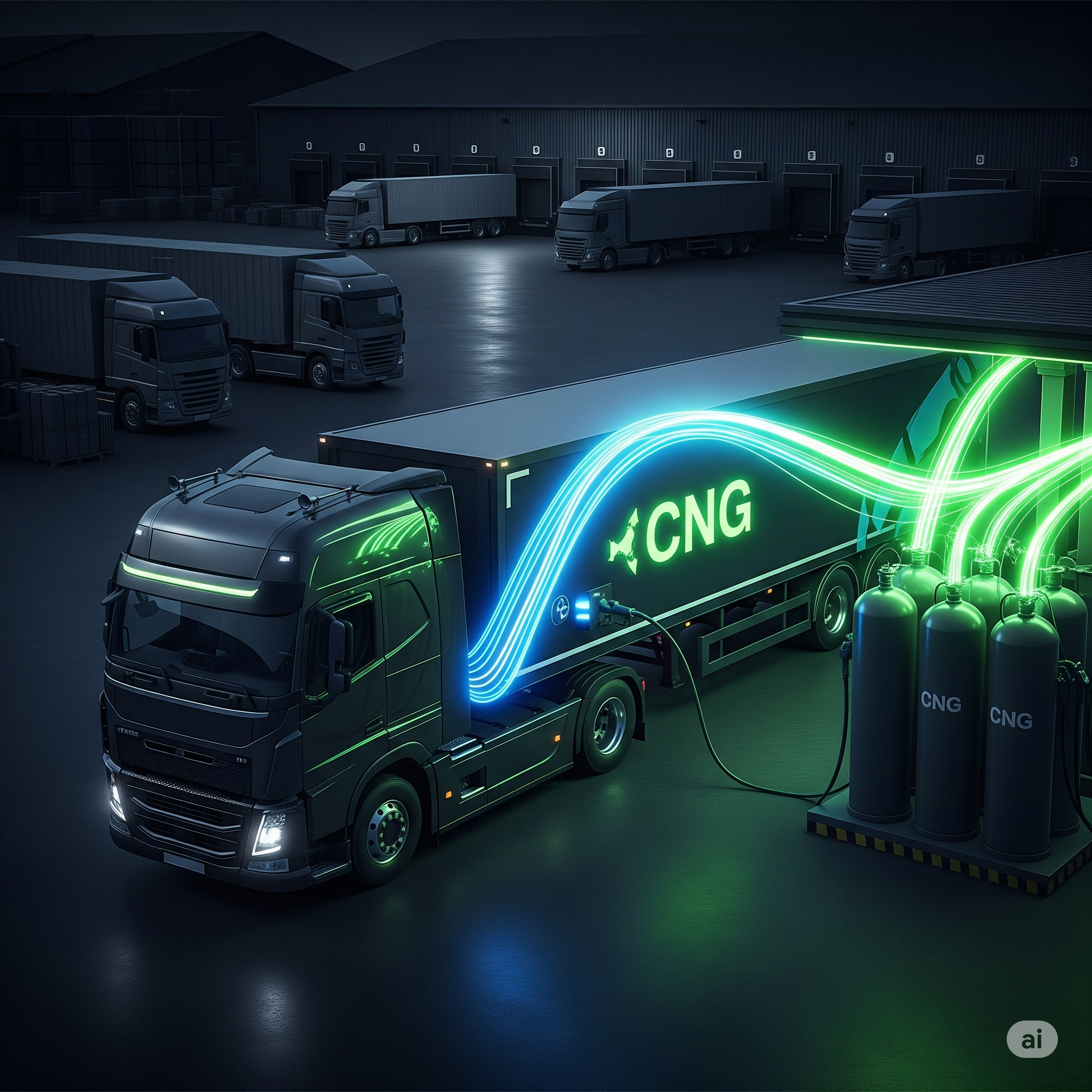Introduction
The logistics and delivery sector is the backbone of the modern economy. With the rise of e-commerce, online retail, and rapid urbanization, the demand for efficient, affordable, and environmentally sustainable transportation solutions has never been greater. Traditional fuels like diesel and petrol have long powered logistics fleets, but rising fuel costs, stringent emission regulations, and increasing environmental concerns have created a shift toward alternative fuels. One of the most promising options in this regard is Compressed Natural Gas (CNG).
CNG has emerged as a viable solution for logistics companies, courier services, and last-mile delivery providers due to its lower operational costs, reduced emissions, and increasing government support. This article explores the use of CNG in logistics and delivery, examining its advantages, limitations, infrastructure challenges, and future potential.
What is CNG and Why is it Important in Logistics?
Compressed Natural Gas (CNG) is a clean alternative fuel made by compressing natural gas to less than 1% of its volume at standard atmospheric pressure. It is widely used in transportation because:
- It burns cleaner than petrol and diesel.
- It reduces harmful greenhouse gas (GHG) emissions.
- It lowers overall fuel expenses.
- It is widely available in countries with abundant natural gas reserves.
In logistics, fuel constitutes a significant portion of operational expenses. Shifting to CNG helps businesses cut fuel costs, meet emission regulations, and adopt sustainable practices. For delivery companies, which rely on fleets of small to medium-sized vehicles, CNG adoption provides both economic and environmental advantages.
Advantages of CNG in the Logistics and Delivery Sector
1. Cost Savings
Fuel expenses often make up 40–60% of logistics companies’ operating costs. CNG is substantially cheaper than petrol and diesel. For instance:
- In India, CNG prices are typically 30–40% lower than petrol and diesel.
- Fleet operators using CNG vehicles report significant reductions in running costs.
This cost advantage allows logistics firms to offer competitive delivery prices and maintain profitability even in volatile fuel markets.
2. Environmental Benefits
CNG vehicles produce fewer harmful emissions compared to traditional fuels:
- 25–30% less carbon dioxide (CO₂) emissions.
- Significantly lower nitrogen oxides (NOx) and particulate matter (PM), which are major contributors to urban air pollution.
- No emission of harmful lead or sulfur compounds.
For delivery fleets operating in urban areas, where pollution is a growing concern, CNG vehicles contribute to cleaner air and improved public health.
3. Government Policies and Incentives
Many governments worldwide are promoting CNG adoption in logistics through:
- Tax benefits and subsidies on CNG vehicles.
- Lower road and toll taxes for eco-friendly vehicles.
- Expansion of CNG refueling infrastructure.
In India, for example, the government’s National Gas Grid Project aims to expand CNG infrastructure, making it easier for logistics companies to switch.
4. Reduced Dependence on Oil Imports
Countries like India, which heavily depend on imported crude oil, can reduce their reliance by encouraging CNG usage. Logistics and delivery companies shifting to CNG help strengthen national energy security.
5. Increased Vehicle Longevity
CNG is a cleaner fuel that causes less engine wear compared to petrol and diesel. Logistics fleets using CNG vehicles report:
- Longer engine life.
- Lower maintenance costs.
- Reduced oil contamination and longer oil change intervals.
This results in better fleet management and long-term savings for logistics providers.
Disadvantages and Challenges of CNG Use in Logistics
While CNG offers several benefits, it also comes with challenges that logistics and delivery companies must consider.
1. Limited Refueling Infrastructure
One of the biggest barriers is the lack of widespread CNG refueling stations. Unlike petrol and diesel, CNG availability is limited to certain urban centers. For long-haul logistics, this poses a major challenge as vehicles may face refueling delays.
2. Lower Energy Density
CNG has a lower energy density than diesel, which means:
- Vehicles require larger fuel tanks to cover the same distance.
- CNG vehicles often have a shorter driving range, making them less suitable for long-haul transportation.
This is a key limitation for logistics companies engaged in intercity or cross-country deliveries.
3. Initial Vehicle Costs
Although running costs are lower, CNG vehicles typically have a higher upfront purchase price compared to conventional vehicles. Additionally, logistics companies may need to invest in specialized CNG-compatible engines or retrofitting kits.
4. Refueling Time
CNG refueling takes longer than filling petrol or diesel, which may reduce operational efficiency for time-sensitive deliveries.
5. Safety Concerns
Although modern CNG systems are designed with strict safety standards, concerns remain regarding:
- High-pressure storage of gas.
- Fire hazards in poorly maintained vehicles.
- Public perception of safety risks.
Proper training and maintenance are essential to overcome these challenges.
Role of CNG in Different Segments of Logistics
1. Long-Haul Logistics
- Advantages: Lower fuel costs, environmental benefits.
- Challenges: Limited refueling stations and shorter driving ranges.
- Future Potential: Integration with hybrid technology may make CNG more viable for long-distance freight in the future.
2. Urban and Last-Mile Delivery
- Advantages: Urban areas often have better CNG infrastructure, and short delivery routes reduce the need for large fuel capacity.
- Popular Among: E-commerce giants (like Amazon, Flipkart, BigBasket in India) are increasingly deploying CNG-powered vans and three-wheelers for last-mile delivery.
- Result: Cost efficiency + eco-friendly branding.
3. Public Distribution and Essential Goods Logistics
- Use in: Milk vans, food delivery, courier services, and pharmacy logistics.
- Reason: These vehicles run short but frequent routes where CNG proves cost-effective and sustainable.
Case Studies
Case Study 1: Amazon India’s Green Delivery Initiative
Amazon has deployed thousands of CNG-powered delivery vehicles across Indian cities. This move is part of its Climate Pledge to achieve net-zero carbon emissions by 2040. The company reports reduced costs and improved brand image among eco-conscious consumers.
Case Study 2: Delhi’s Public Transport Logistics
Delhi, one of the most polluted cities in the world, mandated the use of CNG for buses and certain goods carriers. The shift resulted in significant reductions in particulate emissions, setting an example for other metropolitan areas.
Future Prospects of CNG in Logistics and Delivery
- Hybrid CNG-Electric Vehicles
Combining CNG with electric power can address range issues while ensuring reduced emissions. - Biogas and Renewable Natural Gas (RNG)
Logistics fleets may increasingly use biogas-derived CNG, which is even cleaner and renewable, supporting circular economy models. - Expansion of CNG Infrastructure
Governments are investing in building more CNG stations along highways and in tier-2 and tier-3 cities, which will support logistics beyond metro areas. - Integration with Digital Fleet Management
Advanced telematics and AI-powered logistics solutions will optimize CNG fleet performance, route planning, and refueling schedules.
Conclusion
The use of CNG in logistics and delivery is a practical, cost-effective, and eco-friendly alternative to traditional fuels. While challenges such as infrastructure limitations and shorter ranges persist, the advantages of lower operational costs, reduced emissions, and government incentives make CNG a strong contender in the future of logistics.
For urban last-mile delivery and medium-range logistics, CNG is already proving to be a game-changer. With further technological innovations, expansion of refueling infrastructure, and integration of renewable natural gas, CNG can significantly contribute to building a sustainable logistics and delivery ecosystem worldwide.




